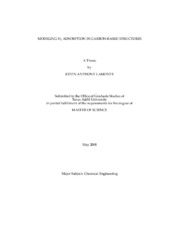| dc.description.abstract | Hydrogen storage has been identified as a primary bottleneck in the large-scale implementation
of a hydrogen-based economy. Many research efforts are underway
to both improve the capacity of existing hydrogen storage systems and develop new
systems. One promising area of research is hydrogen physi-sorbed into carbonbased
structures such as nanotubes and graphene. Two novel systems consisting
of a phthalocyanine salt with a large cation were studied.
Ab initio, density functional theory, and molecular dynamics simulations of
tetramethylammonium lithium phthalocyanine (TMA-LiPc) and trimethyl-(2-trimethylazaniumylethyl)
azanium phthalocyanine (TMA2-Pc) were undertaken to
estimate the H2 gas-solid adsorption uptake (wt/wt) as a function of pressure and
temperature. For TMA-LiPc, the maximum H2 binding energy was approximately
0.9 kcal/mol for an isolated system and 1.2 kcal/mol for a crystal. H2 adsorption
at the optimal inter-layer distance of 8.49 Å ranged from 2.1% to 6.0% (wt/wt) at
300 K, 2.5% to 6.5% at 273K, 3.3% to 7.2% at 236K, 5.2% to 8.6% at 177K, and 10.4%
to 11.7% at 77K. At ILD 10 Å H2 adsorption was about 1.5% (wt/wt) higher at all
points. For TMA2-Pc, the maximum H2 binding energy was approximately 1.3
kcal/mol for an isolated system and 1.2 kcal/mol for a crystal. H2 adsorption at the
optimal inter-layer distance of 8.12 Å ranged from 0.5% to 2.6% (wt/wt) at 300 K,
0.6% to 2.8% at 273K, 0.8% to 3.2% at 236K, 1.4% to 3.9% at 177K, and 4.5% to 6.0%
at 77K. At ILD 10 Å H2 adsorption ranged from about 0.1% (wt/wt) at 40 bar to
0.5% higher at 250 bar. The behavior of H2 adsorption for both TMA-LiPc and TMA2-Pc were compared.
The adsorbed H2 probability density was compared to pair correlation
function data and surfaces of constant binding energy. Regions of relatively high
H2 density appear to correlate well with the binding energy, but the total adsorption
does not, indicating that the adsorption is driven by factors other than binding
energetics.
Lithium ion transport in TMA2-Pc was also investigated for suitability as an
electrolyte medium for use in lithium ion battery systems. | en |


